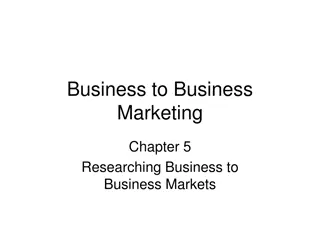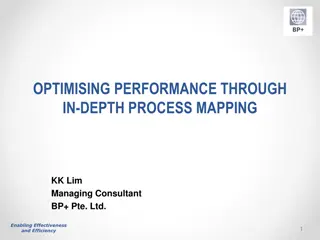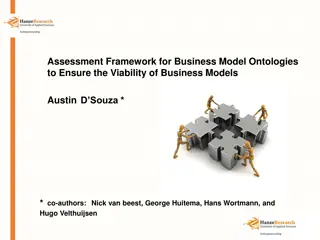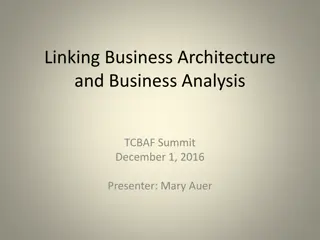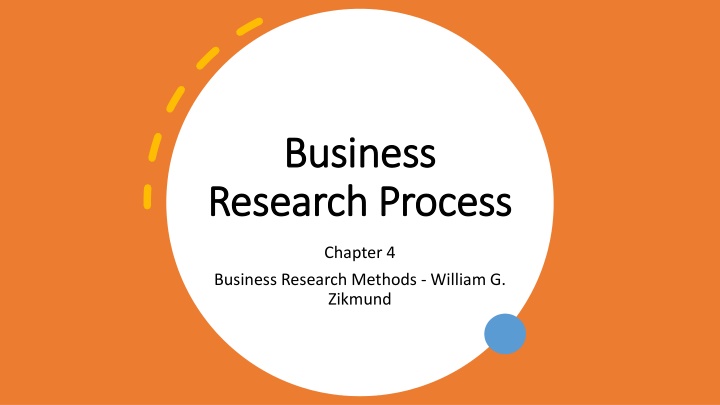
Effective Business Research Methods for Decision Making and Problem Resolution
Explore the different types of business research methods and how they can assist in decision-making and problem resolution. Understand the concepts of business opportunities, problems, and ambiguities, as well as the importance of clarity in research for effective decision-making. Learn about causality, exploratory research, descriptive research, and causal inference to improve business strategies.
Download Presentation

Please find below an Image/Link to download the presentation.
The content on the website is provided AS IS for your information and personal use only. It may not be sold, licensed, or shared on other websites without obtaining consent from the author. If you encounter any issues during the download, it is possible that the publisher has removed the file from their server.
You are allowed to download the files provided on this website for personal or commercial use, subject to the condition that they are used lawfully. All files are the property of their respective owners.
The content on the website is provided AS IS for your information and personal use only. It may not be sold, licensed, or shared on other websites without obtaining consent from the author.
E N D
Presentation Transcript
Business Business Research Process Research Process Chapter 4 Business Research Methods - William G. Zikmund
Decision Making Decision Making business opportunity is a situation that makes some potential competitive advantage possible A business problem is a situation that makes some significant negative consequence more likely An increase in employee turnover is generally only a symptom of a business problem, rather than the problem itself. Research may help identify what is causing this symptom so that decision makers can actually attack the problem, not just the symptom Decision making is the process of developing and deciding among alternative ways of resolving a problem or choosing from among alternative opportunities Sudha Bhagavatheeswaran, Department of Information Technology, SIES College of Arts, Science & Commerce (Autonomous)
Absolute ambiguity to complete certainty Absolute ambiguity to complete certainty Complete certainty means that the decision maker has all information needed to make an optimal decision perfect certainty, especially about the future, is rare. Uncertainty means that the manager grasps the general nature of desired objectives, but the information about alternatives is incomplete. Predictions about forces that shape future events are educated guesses. Ambiguity means that the nature of the problem itself is unclear. Objectives are vague and decision alternatives are difficult to define. This is by far the most difficult decision situation, but perhaps the most common. Sudha Bhagavatheeswaran, Department of Information Technology, SIES College of Arts, Science & Commerce (Autonomous)
Sudha Bhagavatheeswaran, Department of Information Technology, SIES College of Arts, Science & Commerce (Autonomous)
Types of Business Research Exploratory Research Exploratory research is conducted to clarify ambiguous situations or discover potential business opportunities. Exploratory research is particularly useful in new product development 01 Descriptive Descriptive Research Research Describe characteristics of objects, people, groups, organizations, or environments. It addresses who, what, when, where, and how questions. Diagnostic Analysis. Causal Research 02 Causal research seeks to identify cause and-effect relationships. 03
Causality Causal Inference :- A conclusion that when one thing happens, another specific thing will follow Three criteria for causality. Causal research should do all of the following: Establish the appropriate causal order or sequence of events Measure the concomitant variation between the presumed cause and the presumed effect Examine the possibility of spuriousness by considering the presence of alternative plausible causal factor Sudha Bhagavatheeswaran, Department of Information Technology, SIES College of Arts, Science & Commerce (Autonomous)
Criteria for Causality 01 02 03 Temporal Sequence Concomitant Variance Nonspurious Association Means between a cause and an effect is true and not simply due to some other variable. any covariation Deals with the time order of events the cause must before the effect. Occurs events meaning they vary systematically when two covary, occur
Degree of Causality Absolute Causality - Means the cause is necessary and sufficient to bring about the effect Conditional Causality - Means that a cause is necessary but not sufficient to bring about an effect. Contributory causality - Means that a cause need be neither necessary nor sufficient to bring about an effect. Sudha Bhagavatheeswaran, Department of Information Technology, SIES College of Arts, Science & Commerce (Autonomous)
EXPERIMENTS Experiments hold the greatest potential for establishing cause-and-effect relationships. Experiment - A carefully controlled study in which the researcher manipulates a proposed cause and observes any corresponding change in the proposed effect. An experimental variable represents the proposed cause and is controlled by the researcher by manipulating it. Manipulation means that the researcher alters the level of the variable in specific increments. Test-marketing is a frequently used form of business experimentation. A test-market is an experiment that is conducted within actual business conditions. Sudha Bhagavatheeswaran, Department of Information Technology, SIES College of Arts, Science & Commerce (Autonomous)
Uncertainty Influences the Type of Research Sudha Bhagavatheeswaran, Department of Information Technology, SIES College of Arts, Science & Commerce (Autonomous)
Stages in the Research Process Stages in the Research Process Analyzing the data Planning a sample Defining the research objectives 01 03 05 02 04 06 Formulating the conclusions and preparing the report Planning a research design Collecting the data Sudha Bhagavatheeswaran, Department of Information Technology, SIES College of Arts, Science & Commerce (Autonomous)
03 01 04 02 05 06
Defining the research objectives Research objectives are the goals to be achieved by conducting research. In consulting, the term deliverables is often used to describe the objectives to a research client. The research objective may be to simply clarify a situation, define an opportunity, or monitor and evaluate current business operations. This process is oriented more toward discovery than confirmation or justification Defining the decision situation must precede the research objectives Sudha Bhagavatheeswaran, Department of Information Technology, SIES College of Arts, Science & Commerce (Autonomous)
Defining the research objectives Exploratory research : previous research, pilot study Previous research : Literature Review: A directed search of published works, including periodicals and books, that discusses theory and presents empirical results that are relevant to the topic at hand. It is a fundamental requirement of a research report. Pilot Study: A small-scale research project that collects data from respondents similar to those to be used in the full study. A pretest is a very descriptive term indicating a small-scale study in which the results are preliminary and intended only to assist in design of a subsequent study. Focus Group: A small group discussion about some research topic led by a moderator who guides discussion among the participants. Sudha Bhagavatheeswaran, Department of Information Technology, SIES College of Arts, Science & Commerce (Autonomous)
Defining the research objectives formally state the research objectives Linking Decision Statements, Research Objectives, and Research Hypotheses Sudha Bhagavatheeswaran, Department of Information Technology, SIES College of Arts, Science & Commerce (Autonomous) SIES College of Arts, Science & Commerce (Autonomous) Sudha Bhagavatheeswaran, Department of Information Technology,
Planning the Research Design A research design is a master plan that specifies the methods and procedures for collecting and analyzing the needed information. A research design provides a framework or plan of action for the research. Selection of basic research method Sudha Bhagavatheeswaran, Department of Information Technology, SIES College of Arts, Science & Commerce (Autonomous)
Sampling Sampling involves any procedure that draws conclusions based on measurements of a portion of the population Who is to be sampled? How big should the sample be? Select the sampling units Sudha Bhagavatheeswaran, Department of Information Technology, SIES College of Arts, Science & Commerce (Autonomous)
Gathering Data Obtrusive Methods Surveys require direct participation by research respondents. This may involve filling out a questionnaire or interacting with an interviewer. Unobtrusive methods Sudha Bhagavatheeswaran, Department of Information Technology, SIES College of Arts, Science & Commerce (Autonomous)
Processing and Analyzing Processing and Analyzing Data Data Editing: checking the data collection forms for omissions, legibility, and consistency in classification Coding: The rules for interpreting, categorizing, recording, and transferring the data to the data storage media are called codes. Data analysis: The application of reasoning to understand the data that have been gathered. Sudha Bhagavatheeswaran, Department of Information Technology, SIES College of Arts, Science & Commerce (Autonomous)
Drawing Conclusions and Preparing a Report communicating the research results interpreting the research results, describing the implications, and drawing the appropriate conclusions for managerial decisions These conclusions should fulfill the deliverables promised in the research proposal. Research is only as good as its applications. Sudha Bhagavatheeswaran, Department of Information Technology, SIES College of Arts, Science & Commerce (Autonomous)




